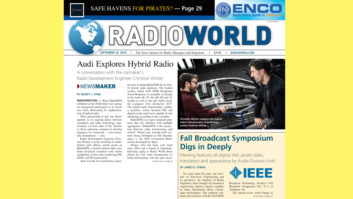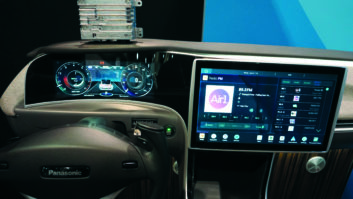WASHINGTON — When RadioDNS exhibited at the NAB Show last spring, an unexpected participant in its booth was Audi, showcasing its implementation of hybrid radio.

Their partnership is just one development in an ongoing dance between carmakers and radio technology organizations on both sides of the Atlantic as these industries continue to develop strategies for connected — and eventually autonomous — cars.
Radio Development Engineer Christian Winter is at the forefront of Audi’s hybrid radio efforts, which center on RadioDNS, a hybrid solution that combines broadcast reception with online capabilities, in this case combining FM, DAB+ and IP functionality.
Audi was the first automotive manufacturer to adopt RadioDNS for its line-fit hybrid radio platform. The hybrid system, called Audi MMI Navigation Touch Response, is available in Europe in the Audi A8, A7, A6, Q8, Q3 and A1 models as well as the new Audi e-tron, the company’s first all-electric SUV. The hybrid radio functionality enables a seamless switch between FM and digital worlds and is now capable of web streaming, according to the carmaker.

RadioDNS is an open standards platform that can interface with multiple aggregators. “RadioDNS is the connection between radio broadcasting and online,” Winter said. Among other systems being developed in this business space is the DTS Connected Radio system developed by Xperi.
Winter, who has been with Audi since 2014 and is based in Ingolstadt, Germany, spoke to Radio World about efforts by U.S. radio broadcasters to build relationships with the auto sector and how they could influence the dash in future connected cars.
Radio World: What does Audi make of the outreach by broadcasters in the United States, and is radio doing enough?
Christian Winter: For Audi, the radio has always been a driver for innovation. With multi-tuner and multi-antenna systems, with touch screens and hybrid radio, we set the bar higher [in] every generation of Audi’s multimedia system. And we don’t want to stop there. We are glad that the NAB has opened this discussion about radio in the connected car and [are] committed to work together with the broadcasting side of the radio industry to bring new features for radio in the connected car.
RW: What do automakers expect from radio broadcasters going forward?
Winter: We want to present radio in a modern and appealing way. To create new features, metadata is a key element. Today radio is not limited anymore to receive metadata only via the small broadcast channel. The IP connection of the car can be used to get detailed data about the station and the running program to the car. Examples are the online station logo, links to podcasts, show descriptions and even phonemes to make the voice recognition better in the car.
RW: How important is it for radio to offer a uniform dashboard experience for all users? What needs to be accomplished for it to happen?
Winter: We at Audi spend enormous effort on user interface and interaction design. For us it is important that all the multimedia features — radio, USB, Bluetooth — have a similar and consistent user interface. Customers are not using one source 100 percent of the time, and when they switch for example from listening to songs on their smartphone via Bluetooth to radio, they expect that radio look and feel similar. They would not accept that a song on the radio does not have an album cover.
Broadcasters can help by offering metadata in a standardized and non-proprietary way. We launched the first hybrid radio with the new Audi A8 in Europe last year and used data provided directly from the stations in a format standardized by RadioDNS.
RW: Tell us about RadioDNS. Is it coming to the US?
Winter: RadioDNS is the not-for-profit membership organization that promotes hybrid radio globally, and creates open technical standards for using IP (internet protocol) technology alongside broadcast radio. There are already selected stations in the US supporting logo distribution in the way described in the RadioDNS standards; but we need more stations to participate.
They have clear benefits, for example that listeners will stay longer on their station because of the usage of IP-streaming in areas where there is no broadcast reception.
RW: Do automakers prefer to see radio become a more interactive medium for its customers in the connected car?
Winter: Radio is valuable because of its great content. But people miss major parts of it because they aren’t on the radio all the time. That’s why we want to give them easy access to on-demand content so that they can listen to their favorite show even when they weren’t in the car when it was initially broadcast.
RW: How does radio fit into the future of the autonomous vehicle and what attributes does broadcasting have to make it an attractive option in the dash?
Winter: There is already a lot of competition for traditional broadcast radio in the connected car with entertainment options like USB, Bluetooth or Apple CarPlay. Radio needs to be attractive for the customer in both content and appearance. Hybrid radio is the key for that, and then people will continue to listen to radio in an autonomous vehicle.
NAB pursues Connected Car Strategies
Officials with the National Association of Broadcasters spent at least part of the summer talking to auto industry execs about the best fit for radio in future connected-car dashboards.
The association’s automotive initiative committee, led by Sam Matheny and Steve Newberry, continues to meet and forge relationships with automotive OEMs to further technical collaborations, according to John Ellis, managing director of Ellis and Associates.
Ellis consults to NAB on automotive issues; he said the group is intent on developing the best content experience for listeners by working with the automotive sector.
“The automotive collaboration is gaining traction. The OEMs are beginning to recognize the radio industry in a way that they are seeing the potential business opportunities, especially with autonomous vehicles. So movement is happening,” Ellis said.
Ellis, who has been global technologist for Ford’s connected car business as well as an executive with Motorola, said NAB partnered with GenIVI, a consortium of auto experts devoted to open software for infotainment systems in the automotive space, to host a private networking event at the TU-Automotive show in June near Detroit.
“The show is dedicated to the head unit in automotive. That’s the in-car dash and navigation systems; and radio is included in that ecosystem. All the OEMs and Tier 1 manufacturers, like Harman Kardon and Samsung, were invited. Our goal has been to get NAB in front of those types of people and to allow for NAB to come to the table when it comes time for technical discussions.“
Ellis said NAB plans to update members on automotive initiative developments at the Radio Show in Orlando this month.
— Randy Stine










